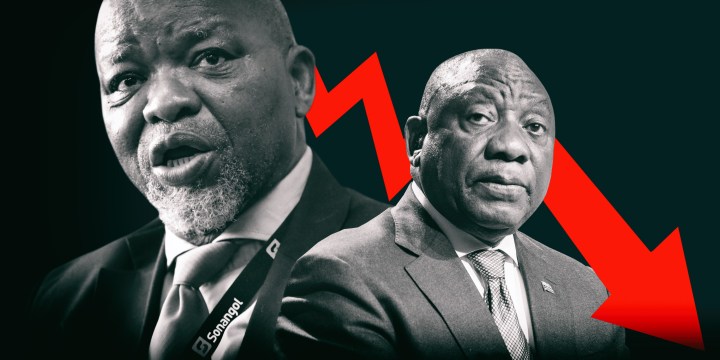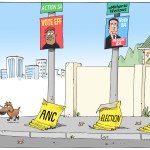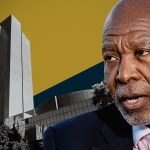GOVERNMENT REPORT CARD
Ramaphosa’s Covid economic recovery plan found wanting, especially on energy reforms

Nearly two years after the Ramaphosa recovery plan was announced, there haven’t been many megawatts added to the national grid from renewable energy sources. In fact, the power crisis has worsened, and the economy is in severe doldrums.
The government has produced a report card on its interventions aimed at helping the economy recover from the Covid-19 pandemic, boost private sector investments and create jobs. The report card suggests partial success, but independent observers are more doubtful.
The government’s progress has largely been found wanting, with the interventions yet to show demonstrable signs of reforming the economy, labour market, or improving the quality of life for citizens. The government’s interventions are contained in its Economic Reconstruction and Recovery Plan, launched in October 2020 when South Africa was in the throes of pandemic lockdowns.
The plan seeks to, among other initiatives, create jobs in three years through public and social programmes, re-industrialise the economy, secure a reliable electricity supply within two years by allowing the private sector to generate more renewable energy, and remove regulatory barriers that increase costs and create inefficiencies in the economy.
Indicators heading in the wrong direction
The government has moved to make positive regulatory changes in key sectors of the economy such as energy, water, transport, and telecommunications. But the Economic Reconstruction and Recovery Plan arguably hasn’t delivered material benefits because South Africa’s key indicators of development are heading in the wrong direction.
Rolling blackouts have returned to uncomfortable levels because Eskom’s creaking power stations continue to break down. Not many megawatts from renewable energy players have been added to the national grid despite the government’s commitment to do so. Unemployment and inequality levels are still at a crisis level. The cost of living crisis has been worsened by high fuel and food prices — and the economy will probably grow by 2% this year — not enough to create a pro-growth, employment and investment climate.
Mmamoloko Kubayi, the Minister of Human Settlements and the ANC’s head of economic policy, has defended the recovery plan, saying it is not a dud. Other economic revival plans drafted by the government and the ANC have fallen short of implementation.
‘July unrest and flood setbacks’
During a press briefing on Thursday, Kubayi said the plan was intended for the economy’s recovery from the Covid-19 pandemic — a process which was further complicated by the social unrest in July last year and the floods in KwaZulu-Natal and the Eastern Cape in April this year. Kubayi argued that if it weren’t for the “unexpected” July social unrest and April floods, the plan would have “delivered better results”.
She also pointed to South Africa being “far better” than the developed world, citing consumer inflation rates (a measure of the cost of living) that are closer to 10% in international markets while the inflation rate locally is hovering around 7%.
[Fact check: it was the Reserve Bank’s efforts, and not the government’s, to keep inflation in check. The Reserve Bank was one of the early central banks around the world to increase interest rates in November 2021, foreseeing inflation pressures. Other central banks followed suit in early 2022].
To the government’s credit, much of the progress in its implementation of the plan has been centred on making regulatory changes and changing the fabric of the economy by implementing a small number of pro-growth and investment structural reforms.
Reform delivery
An area in which there has been clear reform delivery is the recent auction of spectrum, which brings the promise of telecommunications companies unleashing investments in the next six months to improve their network quality and lower the cost of mobile data.
The separation of Eskom into three units (generation, transmission and distribution) has been completed. The e-visa system has been revamped to boost the tourism industry. A list of critical skills (although limited) has been published to attract foreign expertise to South Africa. The blue- and green-drop water quality assessment system has been revived for the first time since 2014 to speed up the issuing of licences for the provision of water to communities.
See other reforms below:
 But there is a big difference between announcing reforms and taking demonstrable steps to implement them. The energy sector is a case in point as most reforms have gone awry and face serious implementation delays while the country faces a power shortage crisis.
But there is a big difference between announcing reforms and taking demonstrable steps to implement them. The energy sector is a case in point as most reforms have gone awry and face serious implementation delays while the country faces a power shortage crisis.
A few months after the Economic Reconstruction and Recovery Plan was announced, the government moved to amend regulations to allow private companies to generate electricity for their own needs of up to 100MW without requiring a licence. This didn’t go far enough because rolling blackouts intensified, dragging down the economy with it.
This recently pushed President Cyril Ramaphosa to scrap the 100MW limit, paving the way for no cap on private sector energy generation.
Renewable energy
This is particularly relevant for the recent round of procurement of renewable energy (wind and solar) — known as bid window five, which envisages 2.6 gigawatts or 2,600MW — to be supplied to the country. This round closed at the end of September and renewable energy might be ready for dispatch on the national grid by April 2024.
But energy reforms, also supported by the Economic Reconstruction and Recovery Plan, are far from being implemented for several reasons.
First, there is still no framework in place that will allow municipalities to buy renewable energy from independent power producers and also at a determined price, which will likely deter such producers from feeding power to the national grid.
Visit Daily Maverick’s home page for more news, analysis and investigations
Second, the bid window five programme is in trouble with many of the 25 announced winners unable to reach financial close, meaning they are facing daunting financial challenges. This is because renewable energy players agreed to supply solar and wind power at an average cost of about 43 cents and 49 cents per kilowatt hour, respectively, years ago. And years later, these prices have become too low and don’t allow independent power producers to make any money or recover costs they would incur in building renewable energy projects and supplying energy for South Africa’s needs.
And, the cost of raw materials, such as steel, used in the building of renewable energy projects has skyrocketed due to the Covid-19 lockdowns around the world and shipping delays, which have made deliveries of raw materials slower. So, the increased cost and financial unsustainability of many renewable energy projects in the bid window five programme means that there won’t likely be power from them by next year.
Gwede Mantashe’s performance
Gwede Mantashe, the Minister of Mineral Resources and Energy, is aware of this crisis, but is not willing to amend the terms of the bid window five programme —mainly the tendered price used by renewable energy players to supply wind and solar energy. “We cannot reopen the bid window [with amended prices]… We also have to consider material conditions that they are confronted with [on a case-by-case basis],” Mantashe said during a press briefing on Thursday.
His priority is pressing ahead with the bid window six programme, which seeks to double the amount of energy procured from renewable energy players to 5.2GW, scheduled to be rolled out in April 2023.
At the briefing, Mantashe didn’t offer new or emergency measures to free-up additional energy generation to lessen the extent of the current round of load shedding. He also didn’t announce new measures to improve the maintenance and performance of Eskom’s power stations, mainly the utility’s energy availability factor (EAF) — the percentage of the utility’s power capacity available for delivery — to above 80% by 2024.
The EAF is less than 60% so far this year. Mantashe signed a performance plan with Ramaphosa that runs until April 2024 and puts the responsibility on him to improve Eskom’s EAF, which is deteriorating. DM/BM



















One incorrect statement in this article. The price of steel has dramatically increased because the department of trouble and idiocy (DTI) implemented punitive tariffs on imported steel and other metal products at the request of a local manufacturer who is neither efficient nor able to meet demand more than because of Covid. Our geniuses in charge sabotaging the country for narrow interests of certain parties (just like the tyre idiocy they have implemented).